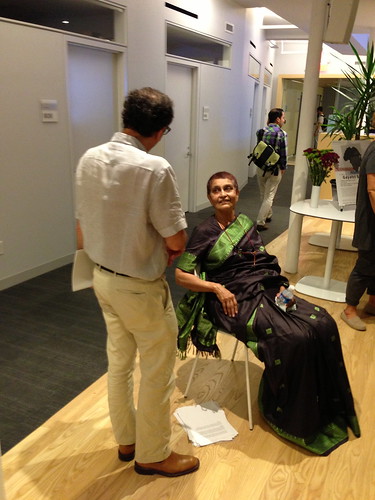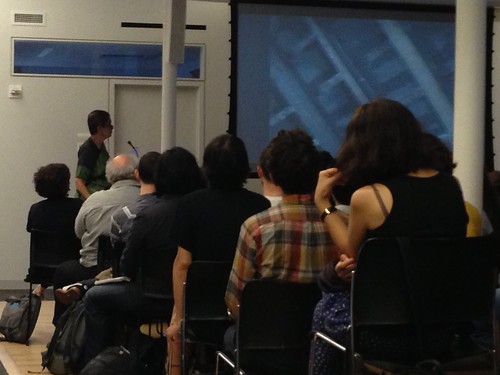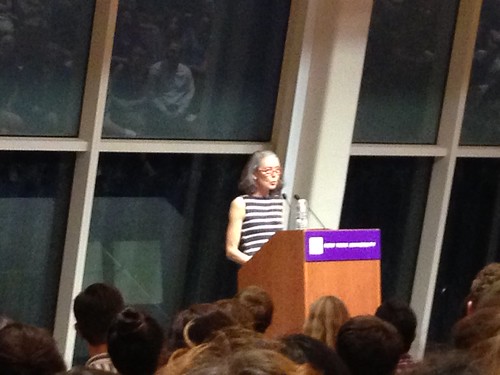
This blog post's title suggests that in some strange confluence two eminent contemporary figures, Gayatri Spivak and Anne Carson, perhaps appeared together at New York University. But that was not the case. This past Thursday, both Spivak and Carson spoke at New York University, though they did so at completely different venues. I do wonder what it would be like to bring them together; what might the points of connection and contact be? Where might their thought intersect? Have they read each other? Something tells me that given the prominence of Spivak's theoretical production and Carson's poetry, perhaps they have at least familiarized themselves, however briefly, with each other's work.
Spivak delivered a talk entitled "Democracy and Representation" that Arjun Appadurai introduced and which NYU's Department of Media, Culture, and Communication hosted, with additional funding from the NYU Africana Studies Program, the Comparative Literature Department, and the Anglophone Project in the English Department. Ostensibly her aim was to speak about the problem of political representation in light of structures and practices international democracy, through a discussion of the late Patrice Lumumba, the first democratically-elected leader of a free Congo (now the Democratic Republic of Congo), who Belgian forces, in collusion with the United States, assassinated shortly after he took office. Her talk was then to shift into a discussion of a new "epistemology for engaging the contemporary by working through the inter-animation between postcoloniality and democracy." She in fact did talk about these issues, but she also spoke extensively, sometimes in Bengali, about her projects working with subalterns in India, and she offered informative sallies, often brimming with generosity, of a range of issues, including the relationship between "democracy" and social justice, the role of ancestor worship in Raoul Peck's Lumumba versus Jacques Brassine's deeply flawed colonialist post-colonial documentary Spectres, Belgium's and European colonization's roles in the spread of HIV in Congo, the reality of "sustained underdevelopment," and the Occupy Movement.

One aspect of her talk that I found most compelling was her discussion of her efforts toward what she called "supplementing vanguardism," which is to say, helping to create a subaltern intellectual, in terms that Antonio Gramsci articulated a century ago. As she noted, she has aimed for "intellectual labor conversations," viewing her work in part as "using intellectual labor to produce intellectual labor in students," moreso than merely imparting information. This, one might say, is part ofthe knew epistemology she was trying to fashion. She went on to talk about this work as "epistemological performance," and, against the obsession with STEM, talked about the necessity for a "training of the imagination," an "aesthetic imagination," which she correlated with "the humanities at work." She also juxtaposed this with the growing systematization and statistization of human development measurement, urging that it be supplemented by the humanities, that a different approach from that of "capital and colony" be taken into account, that we engage in "imaginative activism." As part of her broader critique, she noted that "underdevelopment" did not begin with capitalist colonization, and that this would be clearer if we moved questions of development away from the statistical development model, but that one way to do this was through this imaginative activism, utilizing the power of the humanities at work, but this must entail going beyond mere "activist writing," which could become self-referential and self-satisfied, but have few direct or practical effects for subalterns engaged in struggle. Moreover, political passion alone cannot suffice either. As she said, and as we know just from US history, organization, coalition building, direct action, and other forms of mobilization beyond immediate demands and protests for action, are necessary; "political passion, even when it is incandescent, cannot lead to permanent political structures." (Gramsci, I believe, thinking about Croce.)
There was one moment toward the end when a questioner asked Spivak to explain an incredibly complex formulation that she had made in her talk, and warned the audience about in terms of its difficulty, and, as I have seen her do now many times of the years (at the University of Virginia, at Northwestern, etc.), she basically diagrammed her formulation such that it was not only comprehensible but almost dizzying once you realized what she was saying. I will only say that it involved a formulation about reproductive heteronormativity and its relation to the autonormativity of ideas. At any rate, she returned several times during the Q&A to her emphasis on the necessity of training the imagination to think what is not there, to resisting the impulse to think only of oneself, to using whatever tools--including our two hands--to produce resistance, and to praising the emergence of structures and entities like the Khan Academy, which she nevertheless said must be supplemented by "imaginative training." There was a brief, powerful quote she uttered that I repeated at the MoCADA event, with attribution to her, about how Gramsci noted that "the subaltern is denied the right to abstraction." A great deal of what she has done and continues to do is to challenge this idea, to show and make possible access, among subaltern peoples, to "abstraction," the tools of social justice and liberation. There is, she noted, good and bad in everything; how to understand the difference, and make use of the better aspects of what's around us, including abstract structures such as democracy, money, the law, particularly in the face of the increasing subalternization of the 99%, remains the challenge. This reminds me of Clay's speech to Lula at the end of Amiri Baraka's Dutchman, in which he tell Lula how dangerous he and other black people could be if they use the Enlightenment tools, chiefly reason, instead of sublimating their oppression and transforming it into art. How to use those tools, without losing sight of that aesthetic dimension, is part of what Spivak spoke so evocatively and persuasively about that night.

Having written all of that about Spivak, I must admit that I have less to say about Anne Carson, though she was no less invigorating, in a different way. The MacArthur Foundation Fellow and NYU Distinguished Poet-in-Residence received an affirmative introduction by NYU Creative Writing Program head Joanne Landau, and, it turns out, was reading for the first time in a while at NYU without her husband and frequent collaborator, Robert Currie. She primarily read from her latest work Red Doc> (Knopf, 2013), which takes up the thread of Geryon, the strange, red, unforgettable monster-child from her earlier work, the brilliant novel-in-verse The Autobiography of Red (Knopf, 1998), but she also read assorted older and newer work, including one of the best things I've ever heard from her, one of her dialogues titled "Krapp House," in which she imagines Samuel Beckett's eponymous protagonist from his play Krapp's Last Tape conducting TV interviews various notable historical figures and literary characters. In the "Krapp House" interview she read, Krapp was interviewing Helen of Troy, who made a monstrous choice of her own--captured women vs. her dog; I'll leave J's Theater readers to figure out what Helen did, but let it be said that Carson can treat the profundity of horror, self-absorption, and ethical quandaries, among so many other things, as well as anyone. She ended the event with participatory short talks that were like delicious candies handed out to all who attended. Few writers can bring the house up, then down, then back up again, as deftly as she can. I now will keep my eye ready for announcements about new performances of Red Doc> or anything else she and "Currie," as she called him, are up to.









No comments:
Post a Comment